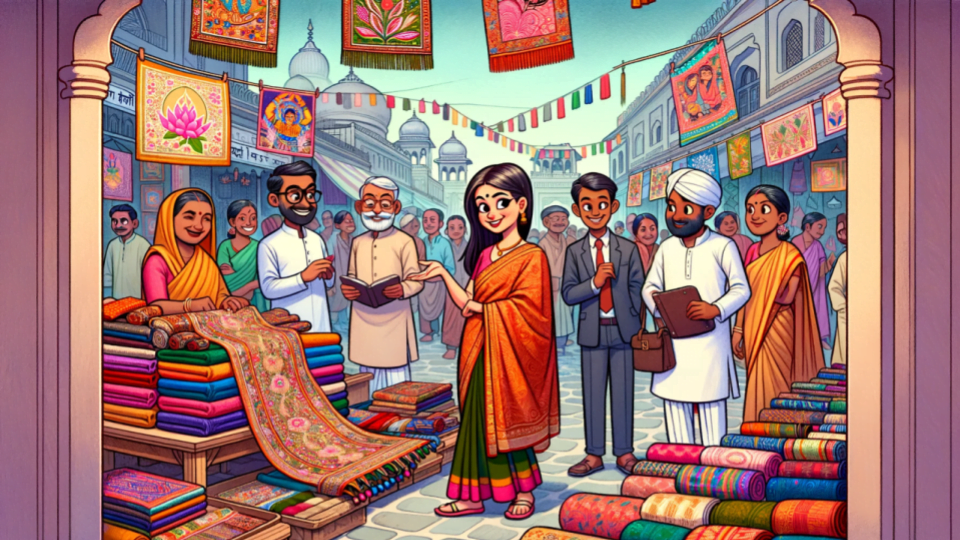Weaving Wins: How Bihart Threads Tradition into Triumph

Founded in February 2020 by Sumati, Bihart embarked on a mission to revive Bihar’s dying crafts. Sumati, driven by a profound connection to her heritage, envisioned a platform where the state’s rich art legacy could shine anew. Her journey into the world of art and antiques began in her childhood, surrounded by the Jalan family’s exquisite collection. This collection, a testament to centuries of artistic excellence, included treasures from Mughal and European courts, alongside manuscripts and masterpieces from around the globe.
Bihart stands as a testament to Sumati’s vision, a brand that intertwines the past with the present. It breathes life into Madhubani paintings, Bhagalpuri Tussar silk weaving, and other near-extinct crafts. Through this venture, Sumati seeks not just to preserve these art forms but to instill a sense of pride and belonging among the people of Bihar. The initiative aims to transform the perception of Bihar, highlighting its cultural richness to the world.
At its core, this is more than a fashion brand; it’s a movement towards sustainable fashion and cultural revival. It champions the cause of artisans and weavers, many of whom had been on the brink of forsaking their ancestral crafts. By offering these crafts a global platform, it ensures that the artistic heritage of Bihar not only survives but thrives.
As we delve deeper, we find a story of resilience, creativity, and dedication. Sumati’s journey from being inspired by her family’s legacy to founding Bihart underscores a deep-seated belief in the power of art to transform society. This tale of revival and empowerment sets the stage for a deeper exploration into Bihart’s world, where tradition and innovation meet to create something truly extraordinary.
Bihart Origins : Stitching the Past to Present
Bihart’s mission to rejuvenate Bihar’s dying crafts is a critical endeavor in preserving India’s cultural heritage. Among these crafts, Madhubani paintings and Bhagalpuri Tussar silk weaving stand out for their historical significance and unique beauty. However, the state’s artistry doesn’t end there. Crafts such as Sujani embroidery, Manjusha art, Khatwa (appliqué work), and Sikki grass weaving, alongside weaving techniques like extra weft, fishnet, Chingari, and Jharna, are at risk of fading into obscurity.
Madhubani painting, a centuries-old art form, is characterized by intricate patterns and vibrant colors, depicting mythology and folk themes. Bhagalpuri silk, known as the “Queen of all fabrics,” is renowned for its unique dying technique and exceptional quality. Sujani embroidery, another significant craft, involves quilting and embroidery to tell stories or depict rural life, while Manjusha art, also known as Angika art, is a form of scroll painting that narrates mythological and religious stories.
The challenge of reviving these crafts lies not just in preserving the techniques but also in making them relevant to contemporary markets. Bihart tackles this by innovating within traditional frameworks, creating products that appeal to modern aesthetics while maintaining the essence of the original craft. This involves teaching and upskilling artisans, introducing them to new motifs, and integrating traditional designs into products that fit into current lifestyle trends.
By focusing on these crafts, they not only contribute to preserving Bihar’s cultural legacy but also empower local artisans by providing them with sustainable livelihoods. The initiative has led to the creation of a range of products, from apparel to home furnishings, that carry the distinct imprint of Bihar’s heritage. Each piece tells a story of tradition, skill, and the artisan’s dedication, making it a unique addition to the global cultural tapestry.
The Bihart Culture Couture : Product Range and Design Philosophy
Bihart’s product range and design philosophy embody a deep respect for Bihar’s traditional crafts, reimagined through a contemporary lens. The brand’s offerings are diverse, spanning Indian wear for both men and women, including mulberry silk-extraweft sarees, fishnet scarves, hand applique and Sujani kurtis, Tussar silk and applique dupattas, cotton-silk Sujani crop tops, and a variety of handmade accessories like belts, bags, and Sujani-Shingari dolls. Home furnishing items such as hand-woven cotton throws, hand applique and Sujani cushions, dohars, and bed covers also feature prominently in their catalogue.
The essence of Bihart’s design philosophy lies in the fusion of traditional craftsmanship with modern aesthetics. Each product is a celebration of Bihar’s artistic heritage, crafted using hand-spun and hand-woven fabric, ensuring that the traditional techniques are not only preserved but also appreciated in new forms. The brand actively works on creating functional, one-of-a-kind products that stand out in the market while staying true to their roots.
This innovative approach extends to Bihart’s business model as well, which adopts an omnichannel sales strategy. With an offline store in Patna and distribution across various stores in India, including in Goa, Bengaluru, Delhi, Udaipur, and Rishikesh, Bihart ensures that its products reach a wide audience. Additionally, the brand harnesses the power of online sales through its website and social media platforms, catering to the digital-savvy consumer.
The design process at Bihart involves closely working with local artisans and weavers, forming a collaborative ecosystem that encourages the exploration of new designs and motifs. This partnership is crucial in creating products that not only resonate with modern consumers but also provide a sustainable source of income for the artisans. By introducing these traditional crafts to contemporary markets, Bihart plays a pivotal role in ensuring their survival and relevance.
Bihart’s commitment to sustainability is reflected in its choice of materials and manufacturing processes. By prioritizing hand-spun and hand-woven fabrics, the brand not only supports eco-friendly practices but also highlights the unparalleled quality of traditional Indian textiles. This approach aligns with the growing global demand for sustainable fashion, positioning Bihart as a forward-thinking brand with a strong ethical foundation.
Community Looms Large: The Social Stitch of Bihart
Bihart’s impact on local communities extends far beyond the revival of traditional crafts; it has become a catalyst for socio-economic transformation in Bihar. By collaborating with around four clusters of weavers and two clusters of artisans, Bihart has established a trust-based relationship that not only preserves cultural heritage but also ensures sustainable livelihoods for these craftspeople.
Each cluster, comprising approximately 12 to 50 members, is integral to Bihart’s operations. The brand’s commitment to working closely with these artisans and weavers is reflective of a larger goal: to empower the local community through employment and skill development. This approach has been particularly effective in encouraging the younger generation to engage with and sustain traditional crafts, countering the trend of migration in search of employment opportunities.
The training and upskilling initiatives led by Bihart have introduced artisans to contemporary design motifs while honing their traditional techniques. This blend of old and new has enabled the creation of products that appeal to modern consumers without losing the essence of Bihar’s heritage. As a result, these crafts have found a place in national and international markets, enhancing the economic prospects of the artisans involved.
Moreover, Bihart’s model promotes gender inclusivity by empowering women artisans to participate actively in the workforce. This not only contributes to the economic development of the region but also fosters a sense of community and shared purpose among the participants. The focus on creating functional, marketable products has led to increased demand, further securing the artisans’ livelihoods and ensuring the continuity of these traditional crafts for future generations.
The positive impact of Bihart on local communities is a testament to the power of social entrepreneurship in driving cultural preservation and economic growth. By providing a platform for Bihar’s traditional crafts, Bihart has not only safeguarded these art forms from extinction but has also created a model for sustainable development that can be replicated in other regions facing similar challenges.
The Business of Being Bihart: A Model Woven for Success
Bihart’s business model is innovatively structured to support its mission of reviving and promoting Bihar’s traditional crafts. At its core, the model is built on an omnichannel strategy, combining online and offline sales channels to maximize reach and accessibility. This approach allows Bihart to cater to a diverse customer base, from local buyers in Patna to international consumers seeking unique, handcrafted products.
The brand’s physical presence in Patna, with an offline store on New Dak Bungalow Road, serves as a tangible connection to the local community and tourists alike. This storefront not only showcases the exquisite craftsmanship of Bihar’s artisans but also acts as a cultural hub, educating visitors about the state’s rich artistic heritage. Beyond the local market, Bihart has expanded its reach by supplying to various stores across India, including Paper Boat Collective in Goa, Vayu Design in Delhi, and others in Bengaluru, Udaipur, and Rishikesh.
Online sales play a crucial role in Bihart’s business model. Leveraging its website and social media platforms, particularly Instagram, Bihart taps into the global market, where there is a growing demand for sustainable and ethically produced fashion. This digital strategy not only broadens Bihart’s customer base but also increases the brand’s visibility, enabling it to connect with consumers who value the story and craftsmanship behind each product.
In terms of funding, Bihart operates with a commitment to sustainability and self-reliance, focusing on bootstrapping and reinvesting profits to fuel its growth and expansion. While specific details on external funding or investment are not explicitly mentioned, the brand’s strategic approach to business development suggests a careful balance between maintaining artistic integrity and achieving commercial viability.
Lessons For Aspiring Entrepreneurs : Bihart’s Blueprint
Bihart’s journey offers invaluable lessons for entrepreneurs, especially those venturing into the cultural and artisan sector. Here are key takeaways that underline the essence of Bihart’s success story:
Passion Drives Purpose:
Sumati’s passion for Bihar’s traditional crafts was the foundation of Bihart. Entrepreneurs should start with a cause they are deeply passionate about, as it provides the motivation needed to navigate challenges.
Sustainability and Ethics Matter:
In today’s market, a focus on sustainable practices and ethical sourcing is not just a value-add but a necessity. Bihart’s commitment to hand-spun and hand-woven fabrics showcases how businesses can thrive by prioritizing sustainability.
Innovation within Tradition:
Bihart demonstrates that respecting tradition does not preclude innovation. Entrepreneurs should look for ways to modernize traditional practices, making them relevant and appealing to today’s consumers.
Community Engagement is Key:
Bihart’s success lies in its close relationship with local artisans and weavers. For startups, building a strong community connection can ensure a sustainable supply chain and authentic product offerings.
Embrace Omnichannel Strategies:
Bihart’s use of both online and offline channels to reach a wider audience emphasizes the importance of an omnichannel approach. Entrepreneurs should leverage multiple platforms to maximize their market reach.
Adaptability is Crucial:
Despite starting just before the COVID-19 pandemic, Bihart adapted its business model to survive and thrive. Startups must be prepared to pivot and adapt to external challenges.
Educate Your Audience:
Bihart had to educate its market about the value of Bihar’s dying crafts. Entrepreneurs should not shy away from the responsibility of educating their audience about the uniqueness and value of their offerings.
Focus on Impact:
Beyond financial success, Bihart’s focus on cultural preservation and providing sustainable livelihoods for artisans illustrates the impact-driven model of entrepreneurship. Businesses that aim to make a positive social or environmental impact can find lasting success and fulfillment.
These lessons from Bihart serve as a guide for new entrepreneurs, especially in the cultural, artisanal, and sustainable sectors, showing that with the right approach, it’s possible to build a successful, impactful business that honors tradition while embracing modernity.
Conclusion : Tying Up the Tapestry of Triumph of bihart
Bihart’s journey from a vision to a thriving brand underscores the profound impact entrepreneurship can have on cultural preservation and economic empowerment. By intertwining traditional crafts with modern business strategies, Bihart has not only safeguarded Bihar’s artistic heritage but also paved a path for sustainable livelihoods for local artisans. This story is a testament to the power of passion, innovation, and resilience in the entrepreneurial world.
As we reflect on Bihart’s accomplishments, it becomes clear that businesses have the potential to be more than just profit-generating entities; they can be vehicles for social change, cultural preservation, and community upliftment. Bihart exemplifies how a commitment to ethical practices, community engagement, and sustainability can forge a brand that resonates deeply with consumers and makes a tangible difference in the world.
As we conclude, let this story inspire you to explore how your entrepreneurial ventures can not only succeed in business terms but also make a meaningful impact on society and culture. Whether you’re an aspiring entrepreneur, a seasoned business owner, or simply someone who appreciates the beauty of traditional crafts, consider supporting initiatives like Bihart.
Discover the stories of other remarkable entrepreneurs through our series of articles. Delve into the green world of Ekta Chaudhary’s Garden Up, learn about the revolutionary Sabjikothi that’s changing the face of agricultural storage, get inspired by Raimathi Ghiuria’s unique journey in the fashion industry, and celebrate the empowerment of Overqualified Housewives turning their skills into successful businesses. Each story offers unique insights and lessons that can enlighten and motivate your entrepreneurial path.
Creative Head – Mrs. Shemi K Kandoth
Content By Dork Company
Art By Dork Company
100 Startups by IIT Madras in 2024: A Landmark Entrepreneurial
IIT Madras, a leader in India’s education and research, embarks on an ambitious journey. In…
Inside Indie Hackers: How a Transparent Community of Founders is
Indie Hackers, established in 2016 by Courtland Allen, is a thriving online community and resource…
Cursor: How 4 MIT Graduates Built the Fastest-Growing AI Startup
Cursor, an AI-powered integrated development environment (IDE), emerged in 2022 as one of the fastest-growing…
Vercel: This Startup Is Quietly Powering the Internet — And
Founded in 2015 by Guillermo Rauch and Naoyuki Kanezawa, Vercel—originally known as Zeit—set out to…
Tella: How This Tiny Team Is Revolutionizing Screen Recording
Tella is a modern screen recording platform built for today’s content creators and video professionals….
CarDekho: How Two IIT Brothers Changed The Way India Bought
CarDekho, a prominent name in the Indian automotive industry, has revolutionized the way people buy,…
Kovai.co: The Startup That Gave ₹14 crore To Its 140
The idea for Kovai.co started when Saravana Kumar, the CEO, was working as a software…




















Leave a Reply
You must be logged in to post a comment.